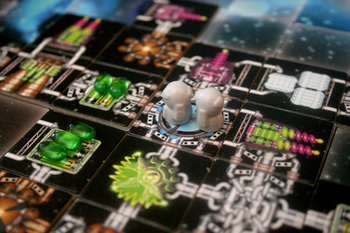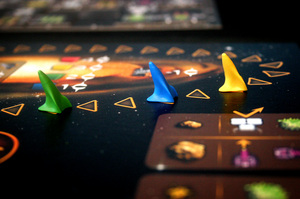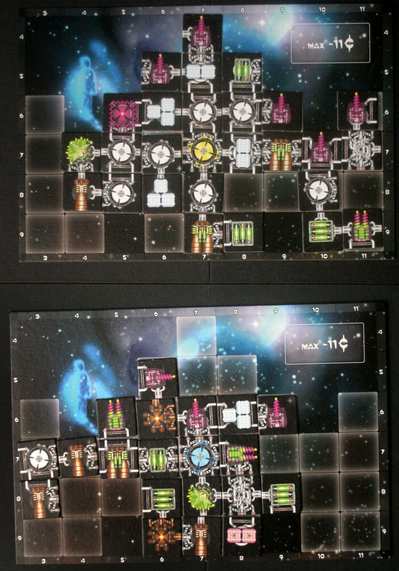Galaxy Trucker: the game where you can have a fun time losing

Mike Hulsebus | Contributor
If you can get utterly destroyed in a game and still have a good time, that's a pretty good indicator that you're playing a good board game. Enter Galaxy Trucker, a game where you and friends build spaceships and try to make it to your destination without your ships being ripped in half by meteors or blown apart by pirates. I ended my first two games with a profit of $0 but still had a lot of fun, perhaps making this the game where I have most enjoyed watching all that I have planned and created be destroyed. Let's take a look at why.
Players simultaneously build spaceships by starting with a pilot's cabin and building outwards. Tiles can only be laid if the connections on the edges of the tiles match up. Once a tile has been placed, it cannot be moved. Players also have two “hold” spaces where they can put components that they want to hold onto to place later. Some connectors are universal can connect to any other connection, but others are more specific. Ideally, you want to build your ship in a way that you can have as many tiles as possible in your ship since each has a function and it's always better to have three lasers than one. Tile functions range from lasers, engines, cargo holds, batteries, shields, and alien life support.

Players keep track over their position relative to the other players. Whoever is ahead after the final card of the journey is drawn will score the most bonus points. Bonus money is also awarded for the prettiest ship: the one with the fewest exposed connections.
Mike Hulsebus | Contributor
The missions flown are the mechanism that you use to see who has done the best job constructing their ship. Players will fly three total missions and the ships and the challenges they face get bigger from one round to the next. Each flight, the players make a common deck of cards that everyone must encounter. Players in the lead of the pack will have first pick of looting planets that come up, but also have to face any attacking ships first.
One of the most fun parts of the game is when things go wrong. Every once in a while, players will enter an asteroid field whose card details a series of attacks that come at each ship. Position of the attack is determined randomly by rolling two six-sided dice (meaning that middle positions are more likely to come up). If a small asteroid hits a component that has an exposed connection (that is—there's a nub sticking up that you didn't connect anything to) you have to either use a battery to fire a shield or lose that component. Larger asteroids can only be destroyed by a laser facing forward in that column.
The way that ships get built, there will be times where losing one component might mean that your ship is no longer completely connected to itself. In these cases, those now-disconnected pieces fall off of your ship and you'll find yourself now piloting a smaller craft. It sounds frustrating and it certainly can be if your ship gets blown the pieces across all three rounds, but for the most part, it's a lot of fun. It's like if you were developing tanks and someone said “let's skip all this scientific testing and instead just shoot at them and see what happens.” As the pieces start falling off your ship and you get closer to your destination, you hope that you ship can hold together long enough to crash-land at port and sell your goods.

Here, two different ships are ready to take flight in the third round of play. Each round has a different silhouette that dictates the bounds in which players must build their ships.
Mike Hulsebus | Contributor
You will like this game if you ever played Microsoft Flight Simulator and turned the malfunction rate up to max just to see if you could land a plane after it lost an engine over Lake Michigan. You'll also like this if you like the Carcasonne-like puzzle of figuring out the best way to put components together to make a ship. It's a great game to play if you're playing to have fun rather than playing to win. Even the rules themselves say that if you make it to the final round with $1 to your name you win, though the players with more money just win more. If you like the tension of rolling dice where one bad roll could mean bad things for you, you'll like this game. This game also appeals to people who shy away from direct, take-that confrontation where each player is trying to sabotage the other players. My wife likes this game and people from my regular gaming group like this game, too.
You won't like this game if the luck elements of the game are a detriment. You might be an expert spaceship builder but not get many guns in the tiles you draw. You might have built your ship nearly perfectly only to have cannon fire hit the one weakness on your ship, removing you from that round. If you want to build space ships so that you can attack your friends, this isn't for you either.
One final note. I traded games online to get this game and so I got it for the price of shipping. I could very well have an entirely different opinion of the game if I had paid for it. The retail price of the game is about $70 (on Amazon you can get it for about $50). If I had no games and you handed me $70 and said “buy the most fun that you can for $70,” I would buy a few smaller games rather than one big game.
So even though it might not be the best bang-for-your-buck game, this is certainly a fun game. I look forward to playing it with a variety of different groups of people and, mostly, I look forward to trying to fly out of a combat zone miraculously unscathed.
Mike Hulsebus still, perhaps erroneously, feels like he would be the best candidate to land a real-life airplane if all the pilots onboard had simultaneous heart attacks: He only needs someone on the radio to point out the location of the F8 key to set the flaps at 100 percent. Mike can be reached at mikehulsebus@gmail.com


Comments
echo
Tue, Aug 17, 2010 : 3:05 p.m.
If I were a pilot and owned a plane, I would totally label all the switches after the function keys for MS Flight Simulator.